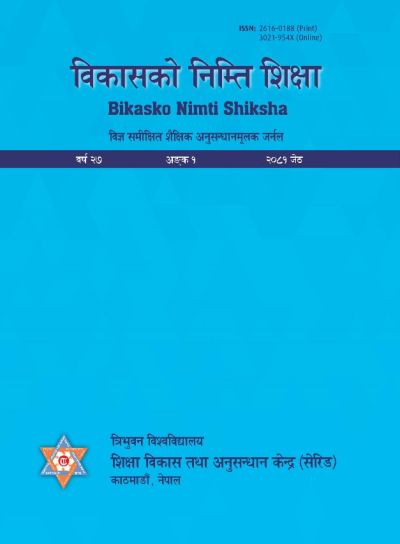नेपाली भाषा पाठ्यपुस्तकमा विषयवस्तुको समावेशिता {Content Inclusiveness in Nepali Language Textbook}
DOI:
https://doi.org/10.3126/bns.v27i1.66455Keywords:
पाठ्यसामग्री reading material, अद्यावधिक विषयवस्त updated content, समावेशिता inclusiveness, स्रोतगत विविधता source diversityAbstract
भाषा पाठ्यपुस्तक भाषिक सिप सिकाइको आधारभूत सामग्री हो । विद्यार्थीहरूमा भाषिक सिप विकासका लागि पाठ्यपुस्तकमा प्रयुक्त विषयवस्तुमा विधागत विविधताको साथै समावेशिता आवश्यक ठानिन्छ । विषयवस्तुप्रति धारणा निर्माण गर्न पाठयपुस्तक महत्त्वपूर्ण सामग्रीका रूपमा रहेको हुन्छ । पाठ्यपुस्तकमा समाविष्ट विषयवस्तुको समावेशिताको अध्ययन गर्नु यस लेखको उद्देश्य रहेको छ । यो लेख गुणात्मक ढाँचामा व्याख्यात्मक विधिमा आधारित छ । कक्षा नौको भाषा पाठ्यपुस्तक नेपाली (२०७९) लाई प्राथमिक स्रोत बनाइएको छ । पुस्तकालयीय अध्ययन प्रक्रियाबाट सामग्री सङ्कलन गरी तयार पारिएको यस अध्ययनमा उक्त पाठ्यपुस्तकमा समाविष्ट विषयवस्तुलाई पाठ्यव्रmम अनुरूपता तथा समावेशिताका आधारमा अध्ययन विश्लेषण गरिएको छ । समग्र पाठ्यपुस्तकले पाठ्यक्रम अनुरूपतालाई मूल आधार मानेको देखिन्छ । पाठ्यपुस्तकमा पाठ्यवस्तुको वितरण भाषिक सिप केन्द्रित देखिन्छ । व्यावहारिक सिप वा व्यवहार कौशल विकासमा विषयवस्तुलाई उपयोग गर्न सकिने किसिमका समसामयिक, अद्यावधिक देखिन्छन् । अध्ययनीय पाठ्यपुस्तकमा भाषागत, जातिगत, लिङ्गगत, फरक क्षमताका सिकारुलाई सम्बोधन हुने गरी पाठ्यसामग्रीको व्यवस्थापनमा जोड दिनुपर्ने देखिन्छ । विषयवस्तुलाई पाठ्यव्रmम अनुरूपताका आधारमा विकास गर्न खोजिए पनि समयानुकूल समावेशिताको अवधारणालाई पाठ्यपुस्तकले पूर्णतः आत्मसात् गर्न सकेको छैन । पाठ्यपुस्तकले विधागत विविधतालाई समेट्दै सिकाइ र विद्यार्थीको जीवन्त अनुभवबिच तादात्म्यता सिर्जना गर्न समसामयिक जीवन अनुभवबाट पाठहरू राख्नुपर्ने देखिन्छ । शोध्य पाठ्यपुस्तकमा समाविष्ट विषयवस्तुहरू भाषागत, जातिगत विविधताका पाठहरूलाई समावेश गर्न आवश्यक देखिन्छ । नेपालको भाषिक, धार्मिक, सांस्कृतिक विविधतालाई समावेशिताको आधारमा उपस्थित गराउन सकेमा प्रभावकारी हुने देखिन्छ ।
{Language textbooks are the basic materials of language skill learning. For the development of language skills in the students, it is considered necessary to include the diversity and inclusive in the subject matters used in the textbook. Textbooks are important material for creating an opinion about the subject matter. The purpose of this article is to study the inclusion of the contents included in the textbook. This article is based on explanatory methods in a qualitative design. The language textbook, Nepali (2079) of class 9 has been made the primary source. In this study, the materials collected from library study, the contents of the textbook have been analysed on the basis of curriculum conformity and inclusion. The entire textbook seems to have considered curriculum conformity as the main basis. In textbooks, the distribution of the contents seems to have centered on language skills. The contents used in the textbook for development of practical skills or behavioral skills appears to be contemporary and updated. In the textbooks of study, emphasis should be laid on the management of textbooks that address the learners of linguistic, racial, gender and different abilities. Although the content has been tried to be developed on the basis of curriculum conformity, the textbook has not been able to fully assimilate the concept of inclusiveness in accordance with time. Textbooks need to incorporate disciplinary diversity and draw lessons from contemporary life experiences to create a close relation between learning and student living experiences. The contents of the research textbooks need to be included in linguistic and ethnic diversity lessons. It would be effective if Nepal's linguistic, religious and cultural diversity could be presented on the basis of inclusivness.}
Downloads
Downloads
Published
How to Cite
Issue
Section
License
Copyright (c) 2024 Author

This work is licensed under a Creative Commons Attribution-NonCommercial 4.0 International License.




